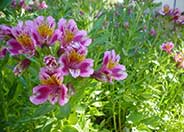
Common name:Heliotrope
Botanical name:Heliotropium arborescens
Heliotropium arborescens is a perennial but typically treated in all regions as a summer bedding annual to 1.5'-2' high and 1'-1.5' wide. Dark violet, purple, blue, or white blossoms are densely set in curved one-sided spikes that form rounded, 3"-4" wide clusters.

Common name:Japanese Boxwood
Botanical name:Buxus microphylla japonica
Japanese Boxwood is often used as a hedge. It is compact, with small bright green leaves. It can reach 4'-6' tall and wide or be kept smaller through pruning. It can be sheared to shape. It does better in areas with milder winters.

Common name:Tuscarora Crape Myrtle
Botanical name:Lagerstroemia 'Tuscarora'
This tree will grow 18'-25' high and 15'-18' wide; it has deciduous green leaves that turn to orange, red, and yellow in the fall. It produces showy red flowers and has brownish green, droopy branches.

Common name:Big Blue Lily Turf
Botanical name:Liriope muscari
Grass-like clumps of dark green leaves 1" wide up to 18" long are found on the Liriope muscari. It can reach a height of 12"-15", and dark blue flowers spikes can be seen held above the leaves during the summer. This is an excellent border, accent or ground cover plant that requires part shade exposure.

Common name:Peruvian Lily, Alstroemeria
Botanical name:Alstroemeria hybrids
The deciduous rhizomes of this Peruvian Lily will often run aggressively if not controlled. They grow best in full to partial sun with some summer watering in dry climates. The florist strains can reach 6' tall, while the compact strains range from 12" 36" tall. For extra long, florist quality stems, stake or grow through netting for support. -Moterey Bay Nursery
Solving Runoff Problems
Importance of Watershed
A watershed is a land area that drains rain and other water into a creek, river, lake, wetland, or groundwater aquifer. Water from your neighborhood also enters the watershed through the storm drain system and flows directly to local creeks without any treatment. It often is contaminated by pollutants that can be toxic to fish, wildlife, and people.Click in the green box for more information
| Designer: Nan Simonsen Nanscapes | Enter My World |
Photographer: GardenSoft |
Soils and Compost:
Incorporate compost 6" into your soil to retain water, reduce compaction, feed earthworms, and provide valuable nutrients to your plants.
Integrated Pest Management:
Remove irrigation water and fertilizer from areas where you don't want weeds to grow.

